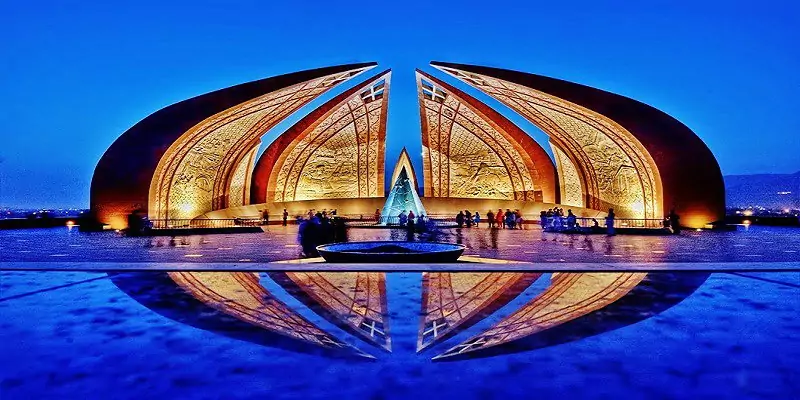Pakistan Monument
The Pakistan Monument, an iconic symbol of the nation's unity and rich cultural heritage, stands majestically at the heart of Islamabad, the capital city of Pakistan. This architectural masterpiece is not merely a structure; it is a tribute to the country's historical legacy, diverse traditions, and the unification of its people. Commissioned to commemorate the nation's progress and achievement, the Pakistan Monument has become a focal point for both locals and visitors, encapsulating the essence of Pakistan's identity.
The idea of constructing a national monument in Islamabad was conceived in the late 20th century, with the intention of creating a symbol that would represent the unity and diversity of Pakistan. The monument's design was chosen through an international competition, and the selected design, created by renowned architect Arif Masood, embodied the cultural and geographical aspects of Pakistan.
Nestled at the west viewpoint of the Shakarparian Hills, the Pakistan Monument offers panoramic views of the city and its surroundings. The location itself adds to the monument's significance, providing a picturesque setting against the backdrop of the Margalla Hills National Park. The monument complex includes a museum, a reference library, and beautifully landscaped gardens, making it a comprehensive destination for both reflection and exploration.
The architectural design of the Pakistan Monument is a harmonious blend of modern and traditional elements. The main structure consists of four towering petals, representing the four provinces of Pakistan: Punjab, Sindh, Khyber Pakhtunkhwa, and Balochistan. These petals converge at the top, forming a symbolic blossom that signifies the unity of the nation. The central structure is surrounded by three smaller monuments, representing the three territories: Azad Jammu and Kashmir, Gilgit-Baltistan, and the Federally Administered Tribal Areas.
Approaching the Pakistan Monument, visitors are greeted by the grandeur of the structure and the intricacies of its design. The use of white marble and granite imparts a sense of elegance and timelessness to the monument. The detailing on the petals includes delicate Islamic patterns, calligraphy, and symbolic motifs, reinforcing the nation's cultural and religious heritage.
The monument complex is accessible through a well-designed road that leads visitors to the main entrance gate. The gate itself is a piece of art, featuring intricate tilework, geometric patterns, and verses from Pakistan's national anthem. The meticulous detailing sets the tone for the architectural richness that awaits within the monument complex.
Beyond its symbolic representation, the Pakistan Monument complex hosts a museum that delves into the nation's history, struggles, and achievements. The museum's exhibits showcase artifacts, documents, and multimedia presentations that chronicle Pakistan's journey from its inception in 1947 to the present day. Visitors can explore the diverse cultural heritage, historical milestones, and the vision that shaped the country.
Adjacent to the museum is the Pakistan Monument Reference Library, a repository of literature, documents, and research materials related to Pakistan's history, culture, and socio-political landscape. The library serves as a resource for scholars, researchers, and enthusiasts seeking to deepen their understanding of the nation's multifaceted identity.
The gardens surrounding the Pakistan Monument are meticulously landscaped, providing a serene environment for visitors to enjoy nature and reflect on the nation's unity. The green expanses are adorned with flowering plants, water features, and shaded walkways, creating a tranquil atmosphere. The strategic positioning of the monument within these gardens encourages a sense of contemplation and connection with Pakistan's natural beauty.
The evening illumination of the Pakistan Monument adds a magical touch to its already striking presence. As the sun sets, the monument is bathed in a warm glow, creating a captivating spectacle against the backdrop of the darkening sky. The play of light accentuates the architectural details and enhances the monument's visual appeal, making it a must-visit destination during different times of the day.
The Pakistan Monument has become a symbol of national pride and patriotism, attracting visitors from across the country and beyond. It serves as a venue for national celebrations, cultural events, and ceremonies that mark significant occasions in Pakistan's history. The annual Pakistan Day celebrations, held at the monument, bring together people from all walks of life to commemorate the Lahore Resolution of 1940.
The monument's significance extends beyond its role as a static structure; it has become a dynamic space for cultural exchange and expression. The open areas around the monument often host art exhibitions, music festivals, and public gatherings that celebrate the diversity of Pakistan's arts and traditions. This inclusive approach reflects the monument's role as a symbol of unity in diversity.
In recent years, efforts have been made to enhance the visitor experience and preserve the monument's legacy. Renovation projects have aimed to maintain the structural integrity, improve landscaping, and introduce modern amenities without compromising the original design. These initiatives align with the broader goal of ensuring that the Pakistan Monument remains a vibrant and relevant symbol for future generations.
The Pakistan Monument is not just a national symbol; it has become an integral part of Islamabad's cultural and tourism landscape. Its strategic location, coupled with the engaging exhibits and serene surroundings, makes it a destination that appeals to both locals and tourists. Visitors can explore the museum, enjoy the gardens, and appreciate the panoramic views, creating a holistic experience that captures the essence of Pakistan.
The Pakistan Monument in Islamabad stands as a testament to the nation's unity, diversity, and historical journey. From its striking architectural design to its role as a cultural hub, the monument encapsulates Pakistan's rich heritage and identity. As a symbol of national pride, it continues to inspire and evoke a sense of belonging for those who visit, contributing to the collective narrative of Pakistan's evolving story.

